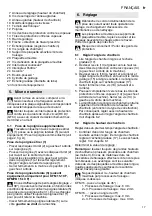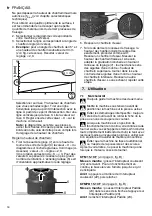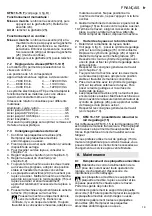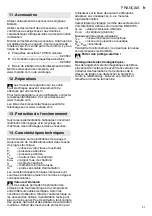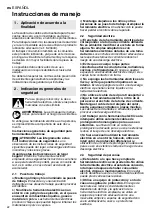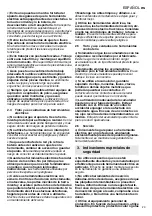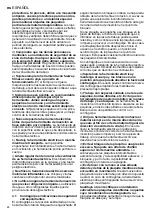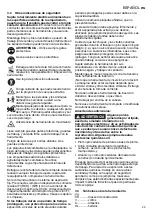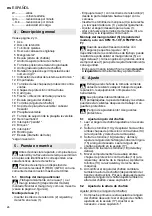
ENGLISH
en
11
Regularly check the indexable insert holder (19).
Repair/replace damaged or worn holders for the
indexable inserts.
Regularly check all indexable inserts (20). Change
damaged or worn indexable inserts.
Turn/replace blunt indexable inserts or inserts
where the coating is worn in due time. Blunt
indexable inserts increase the risk that the machine
will catch and breaks loose or that the indexable
insert plate holder (19) is damaged.
Do not use heavily worn or defective indexable
insert plates.
Always turn or replace all indexable inserts.
Use only indexable inserts approved by
Metabo. See the Accessories Section.
Figure A: Normal wear: turn / replace indexable
insert.
Figure B: Wear after working on hard materials: turn
/ replace turning plate. In the event of heavier wear,
do not use the indexable insert plate and instead
replace.
1. Loosen the screws (13) and slide one chip
protection plate (14) upwards.
2. Turn the indexable insert holder (19) manually if
necessary.
3. Unscrew the fastening screw (21) and remove
the indexable insert (20).
4. Clean indexable insert (20) and clamping
surfaces on the indexable insert holder (19).
5. Turn the indexable insert or, if all blades are
blunt, replace the indexable inserts.
6. Fix again the indexable insert (20) with a
fastening screw (21). Torque: 3.5 Nm.
7. Slide the chip protection plate (14) all the way
down. Tighten the screws (13).
Note:
Causes for indexable inserts with broken
corners or, in extreme cases, for broken indexable
inserts, can include:
- Impacts on the indexable insert due to incorrect
use: See chapter 7.3.
- Workpiece vibrations: Fix workpiece without
vibrations using clamping devices.
- Indexable insert not correctly fastened: Always
clean clamping surfaces and note torque.
- Indexable insert not correctly fastened: Strongly
worn Indexable inserts do not have sufficient
contact surfaces and therefore may not be
fastened sufficiently. Replace the strongly worn
indexable inserts.
Pull the mains plug out of the socket.
Chips and particles can deposit at the milling head
(19). This can lead to blockage of the milling head.
Regularly clean the milling head and its
surroundings and remove chips and particles.
It is possible that particles deposit inside the power
tool during operation. This impairs the cooling of the
power tool. Conductive build-up can impair the
protective insulation of the power tool and cause
electrical hazards.
The power tool should be cleaned regularly, often
and thoroughly through all front and rear air vents
using a vacuum cleaner. Prior to this operation,
separate the power tool from the power source and
wear protective goggles and a dust mask.
KFM 15-10 F, KFMPB 15-10 F:
The electronic signal indicator (11) lights
up and the load speed decreases.
There is
too much load on the machine! Run the
machine in idling until the electronic signal indicator
switches off.
-
The machine does not start. The
electronic signal indicator (11) flashes
(depending on the model).
protection is active. If the mains plug is inserted with
the machine switched on or if the power supply is
restored following an interruption, the machine
does not start up. Switch the machine off and on
again.
KFM 16-15 F:
-
Restart protection:
if the mains plug is inserted
with the machine switched on or if the power
supply is restored following an interruption, the
machine does not start up. Switch the machine off
and on again.
-
Overload protection: there is a reduction in
load speed. The coil temperature is too high!
Allow the machine to run at idle speed until it has
cooled down.
- Switching on the machine briefly reduces the
voltage. Unfavourable mains power conditions
may have a detrimental effect on other machines.
Power impedances less than 0.4 ohm should not
cause malfunctions.
Use only genuine Metabo accessories.
Use only accessories that fulfil the requirements
and specifications listed in these operating
instructions.
A
B
9. Cleaning
10. Troubleshooting
11. Accessories

















